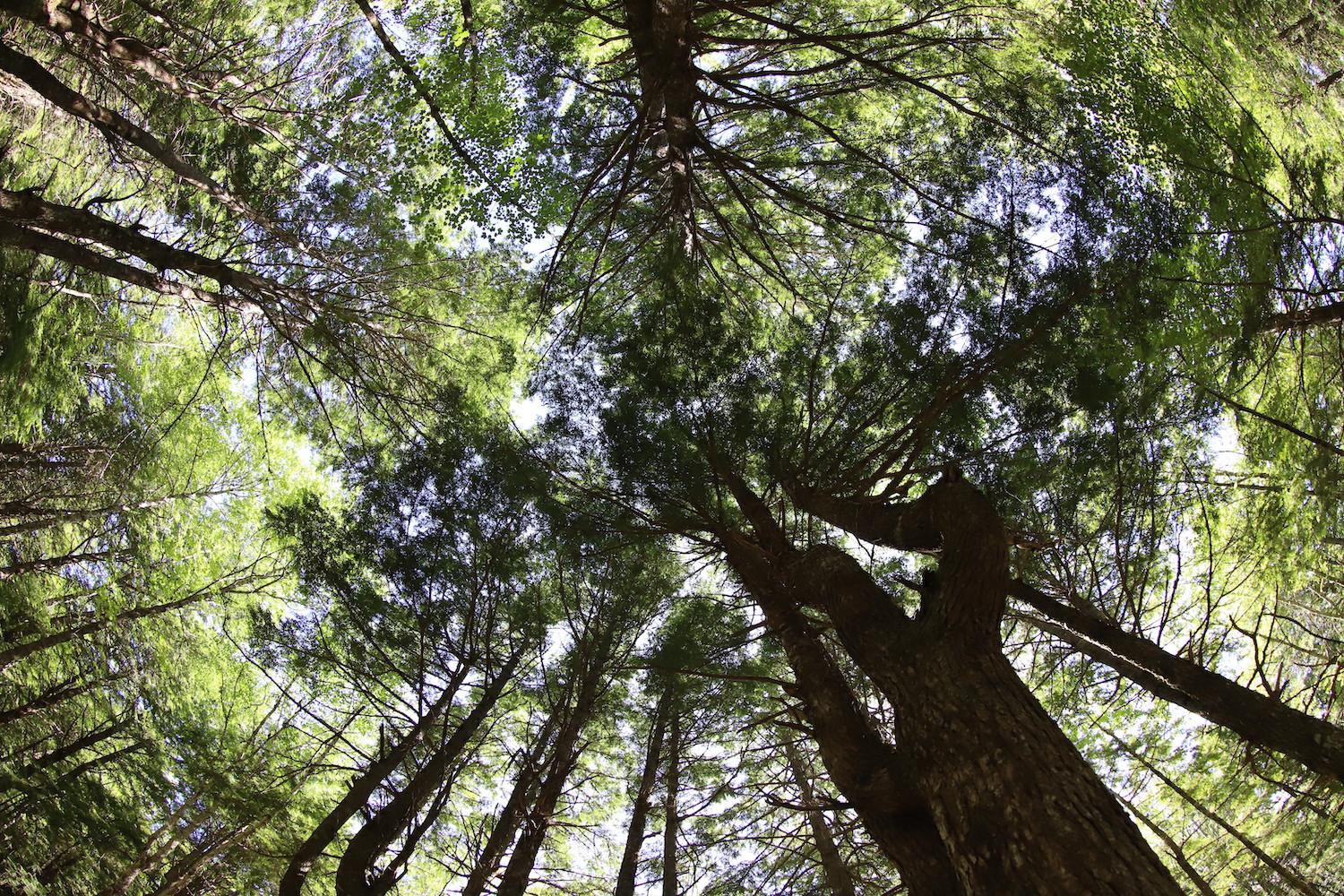
Kejimkujik National Park and National Historic Site visitors have a special relationship with old-growth hemlock stands/Parks Canada
Walking Among Kejimkujik’s Troubled Hemlocks
By Jennifer Bain
On route to an old-growth Eastern hemlock stand, we’re waylaid by a hiker keen to share her sighting of a lady’s slipper, a prolific orchid with a pink, pouch-shaped flower that she has confused with the rare Hooker’s orchid the park wants citizen scientists to keep an eye out for. We pause to admire ruby red teaberries and bunchberries with tiny but showy white “flowers” made up of four oval bracts, rub sweetfern to inhale its namesake scent, and gently finger the ragged lung lichen that proliferate on tree trunks.
The “gentle wilderness” in Kejimkujik National Park and National Historic Site — Keji to locals — is alive with chattering red squirrels and chirping warblers on this cool and overcast June day in Nova Scotia. As promised, the Hemlocks and Hardwoods trail soon transitions from a lively section of hardwoods to a still and shaded patch of softwood hemlocks.
Majestic and mesmerizing, hemlocks are at the heart of Keji experience, but they’re under threat from an invader that hails from Japan via the United States.
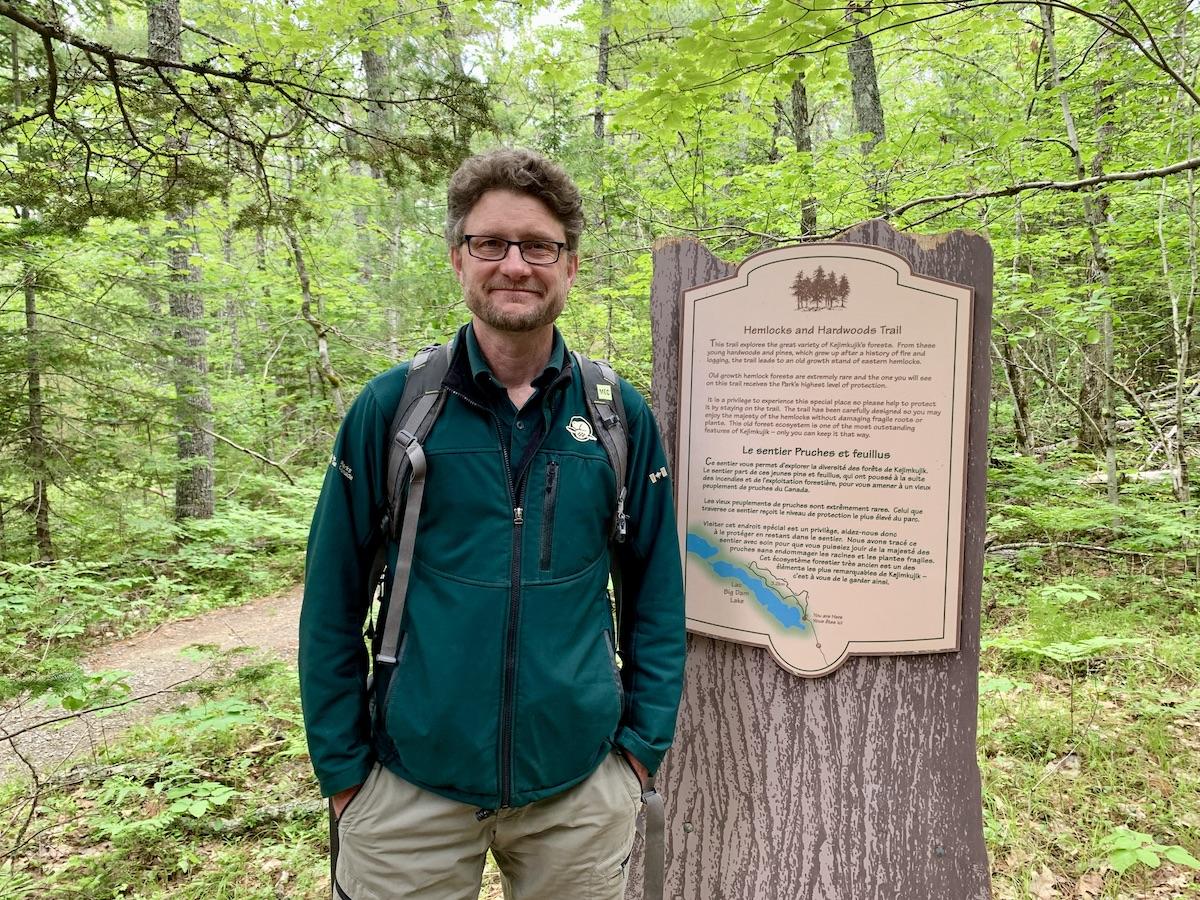
Parks Canada nature legacy ecologist Matt Smith on Kejimkujik's Hemlocks and Hardwoods trail/Jennifer Bain
Matt Smith, a nature legacy ecologist with Parks Canada, reaches his hand off the boardwalk to a random hemlock and flips a branch to reveal several small, woolly masses near the base of the needles that look like cotton swab tips. This is the Hemlock Woolly Adelgid (HWA), an invasive aphid-like insect that was detected in southwest Nova Scotia in 2017 and in the park in 2018.
“It’s not an insect that eats the needles,” explains Smith. “It’s a sucking insect.”
Smaller than a poppyseed, the adelgid grows a protective woolly mass around itself, lays eggs and releases “crawlers” that will soon cover these branches and suck the nutrients out of the tree with their three-part mouths.
“This tree is small and it’s already impacted,” says Smith quietly. “It hardly has any new growth.”
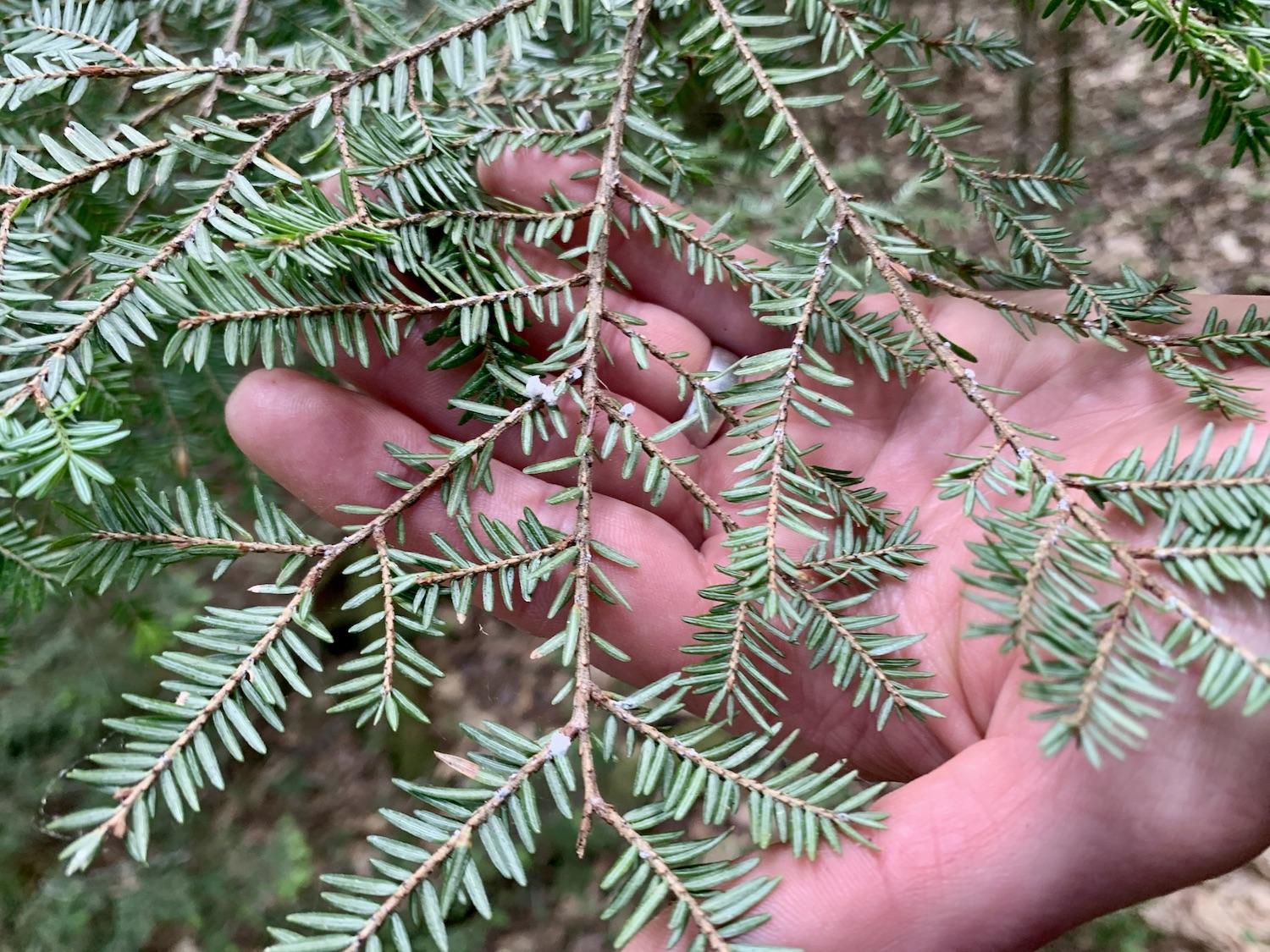
Look closely and you can see several HWA nests that look like cotton/Jennifer Bain
Scientists fear that HWA is poised to decimate up to 80 per cent of hemlocks around here by 2030. That doesn’t bode well for the forest itself — or for the visitor experience in the park. People are drawn to Keji for the chance to walk among ancient hemlocks along this popular trail, in Jeremy’s Bay Campground and around the visitor center and Mill Falls trail.
Parks Canada and its multi-stakeholder working group are being proactive. Campers must buy firewood from the non-profit Friends of Keji Cooperating Association. Infected hemlock stands have been removed and their wood transformed into memorial benches, deer fences, tables and live edge stairs. New species are being planted to diversify the forest. Key trees have been injected with a pesticide that offers short-term protection. An experimental pesticide is being tested.
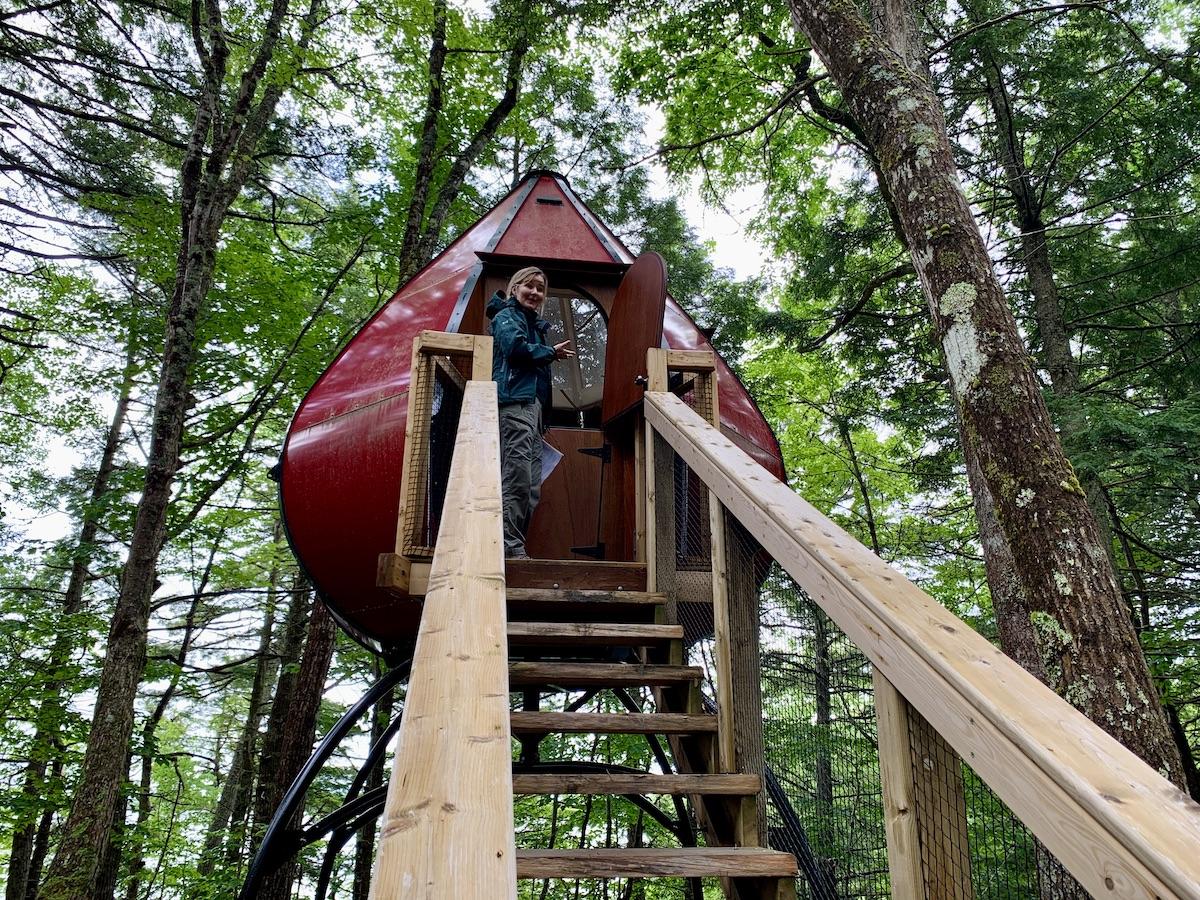
Sophie Borcoman, Keji's visitor experience manager, shows how the roofed accommodation called Ôasis incorporated hemlock into its stairs/Jennifer Bain
Keji protects hemlocks but also rolling hills, Acadian forest and interconnected waterways. It draws a loyal following of people who want to canoe, camp and connect with nature.
Two hours southwest of Halifax, near the Yarmouth and Acadian Shores region and in the UNESCO Southwest Nova Biosphere Reserve, Keji is a Dark Sky Preserve. It’s also the only national park in Canada that has dual status as a national historic site because it also protects a cultural landscape that celebrates the long presence of the Mi’kmaq. The park’s name comes from the Mi’kmaq word Kejimkuji’jk (little fairies) and Kejimkujik Lake used to be known as Fairy Lake. Guided tours of a lakeside petroglyph site are popular.
Pre-pandemic, Atlantic Canada’s only inland national park logged about 70,000 annual visitors. Some drive another hour south to do coastal hikes in a small, separate area of the park known as Kejimkujik Seaside that was added in the late 1980s.
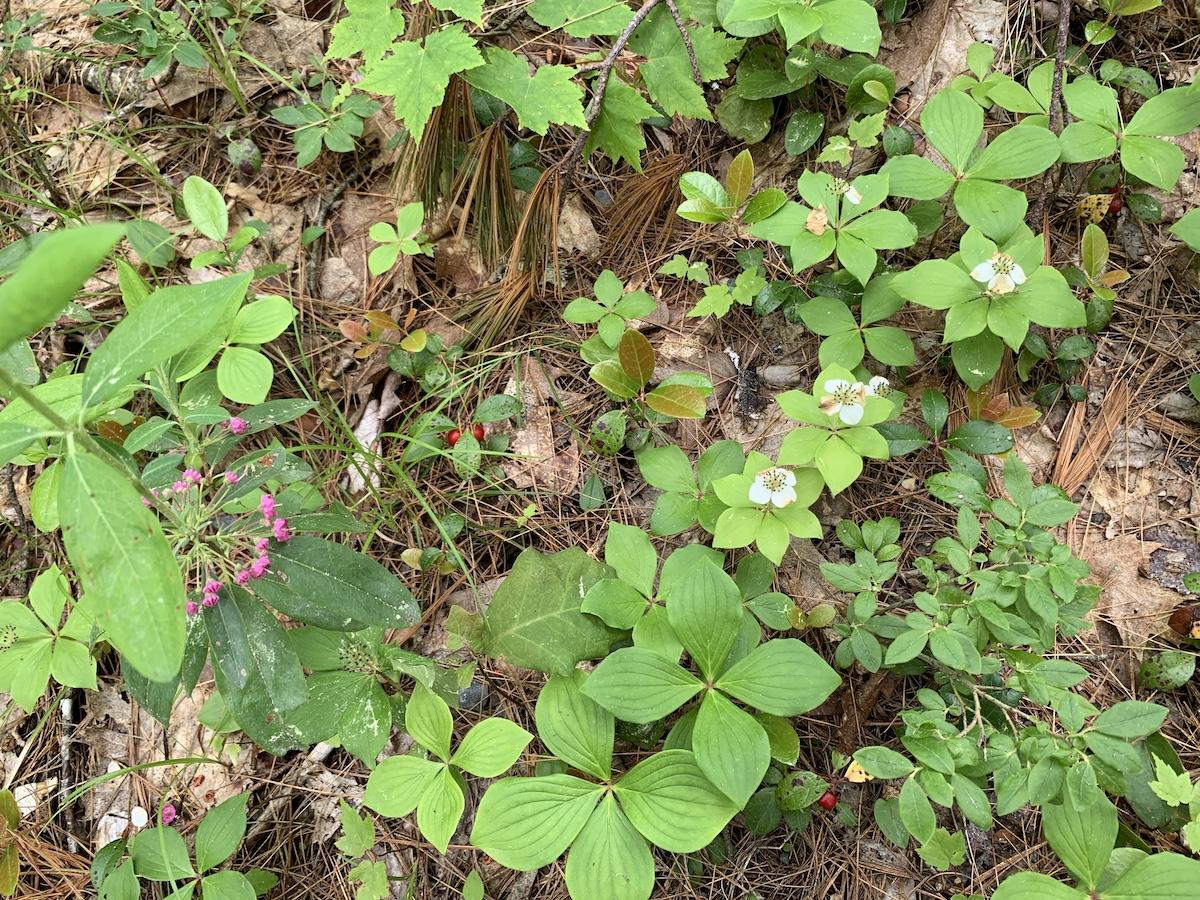
Some of the flowers and berries found along the Hemlocks and Hardwoods trail/Jennifer Bain
Kejimkujik inland lies within the Acadian forest region, a transition between typically southern deciduous (hardwood) trees and typically northern evergreen (softwood) trees. Over the last two centuries, farmers have cleared hardwoods here while loggers have cut red spruce and white pine and then harvested wood for pulp. They avoided hemlock, luckily, because it wasn’t as valuable. The land was acquired from the province in 1967 and the park was established in 1974 to protect the forest from further commercial cutting.
Trees are the star of the iconic five-kilometre (three-mile) Hemlocks and Hardwoods trail. Interpretive signs tell the history of this forest, but don’t yet acknowledge the new pest that is destroying it.
“We’re working on a story for the visitors,” acknowledges Smith. The park does hand out a Nova Scotia Hemlock Initiative brochure called “A Landowner’s Introduction to Hemlock Woolly Adelgid” and posts HWA bulletins around the washrooms and visitor center.
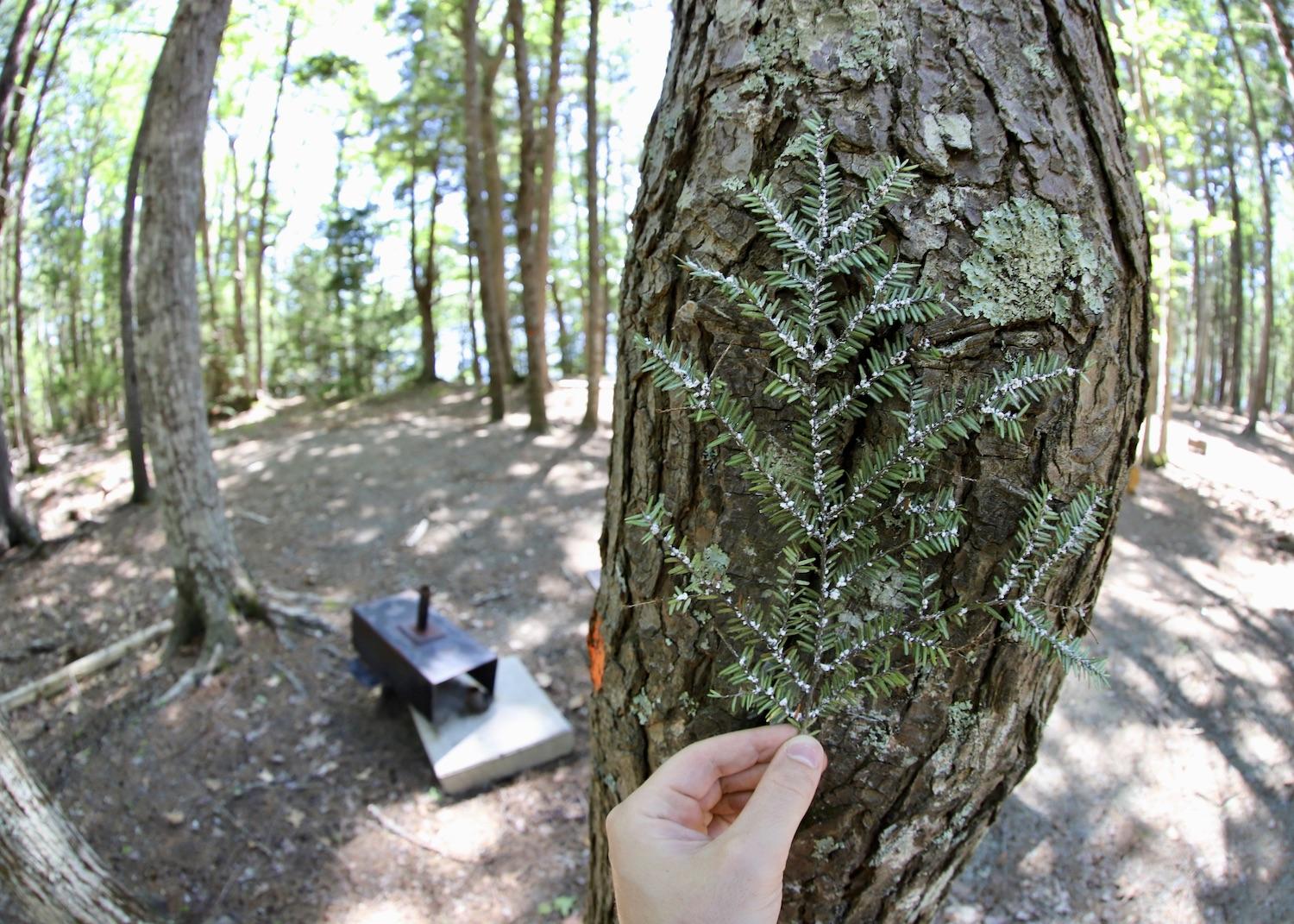
This file photo shows a hemlock branch that's heavily infested with HWA/Parks Canada
HWA — Adelges tsugae — was likely brought to North America on infested nursery stock from Japan. It surfaced in Virginia in 1951 and has been advancing up the eastern seaboard ever since.
In Japan, China, India and Taiwan, the adelgid is controlled by natural enemies and host resistance. Short-lived populations in Ontario were caught early and quickly eliminated. But HWA has no known natural predators in Nova Scotia.
All HWA are female and reproduce asexually, meaning it only takes one to multiply.
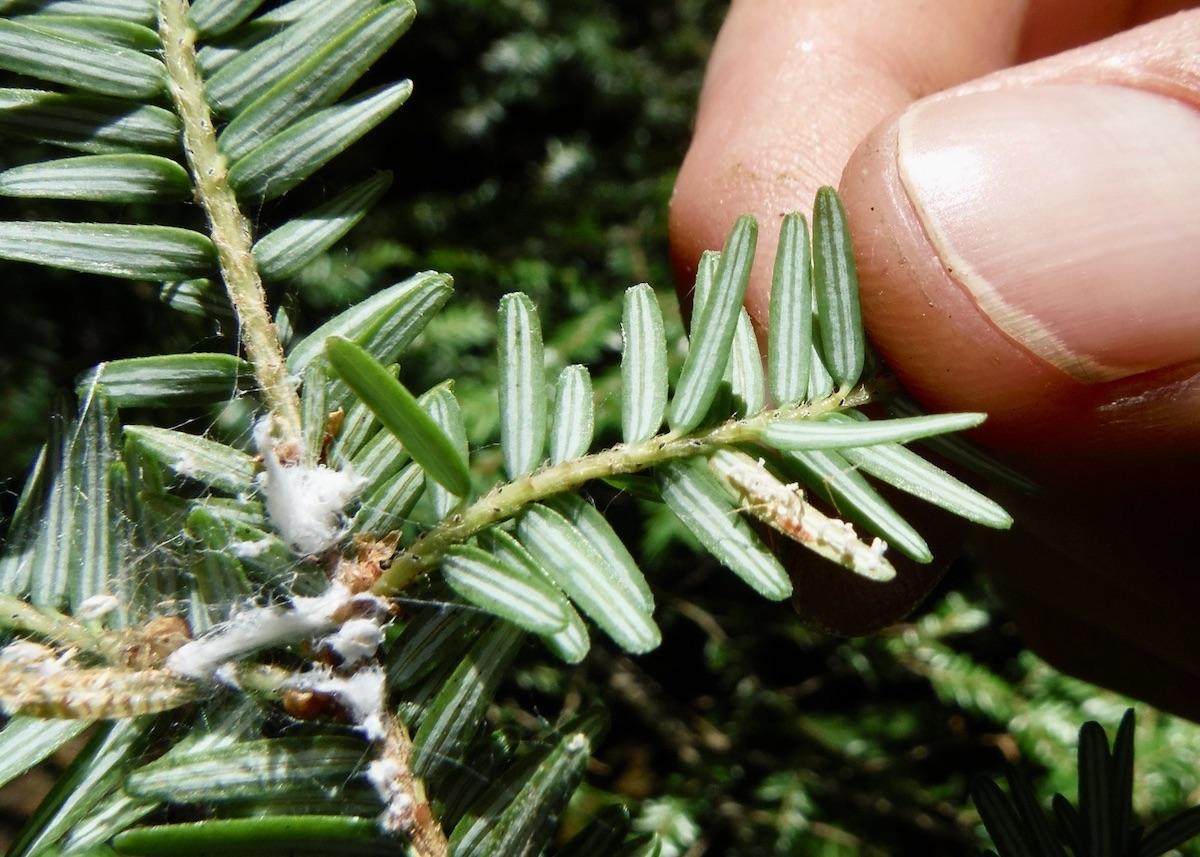
This file photo provides a closer look at HWA on a hemlock branch/Parks Canada
From September to April, the aphids attach to the hemlock by their straw-like mouthparts inserted directly into the hemlock twig near the base of a needle. From April to August, the eggs hatch into multiple mobile nymphs (“crawlers”).
There are two generations per year, according to a Canadian Food Inspection Agency fact sheet. The wingless sistens generation hatches in late spring, lives through the summer, overwinters and survives about nine months. The progrediens generation hatches in early spring, can be wingless or winged, and lives for about three months. Adelgids lay eggs in single batches of 250 to 300 at a time.
“They pretty much are feeding all year except early summer and early fall,” says Smith.
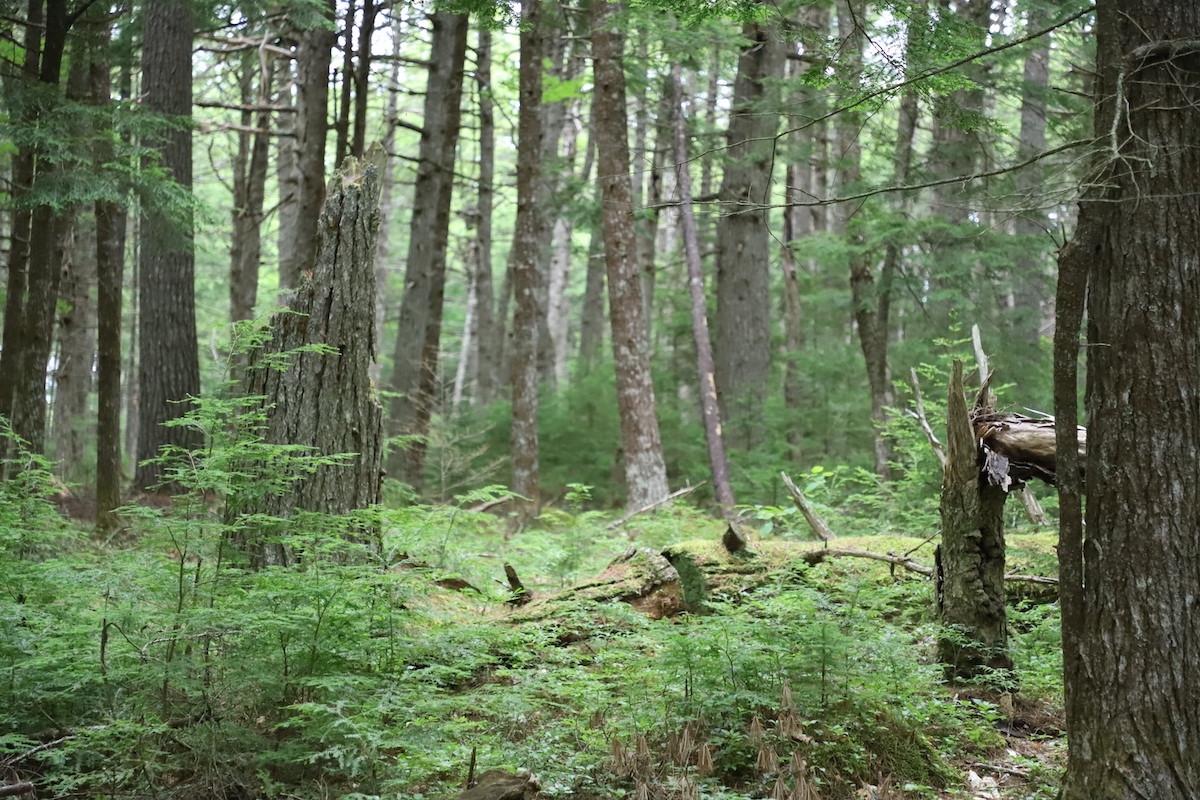
A healthy hemlock forest is full of moss and is darker than hardwood forests/Parks Canada
HWA is passively spread by wind, birds, animals and humans, and hemlock decline isn’t obvious until it’s too late. Infected trees lose needles and their shiny, dark green crowns thin and turn grey-green.
But hemlocks can be protected by treatment with systemic insecticides. In Canada, that means a direct stem-injection of imidacloprid, a neonicotinoid pesticide that is spread by the vascular system of the tree and kills HWA as it feeds. This injection is expensive, though, so trees must be prioritized, and the protection only lasts up to seven years.
As we amble down the Hemlocks and Hardwoods trail, well-spaced interpretive signs paint a picture of what we’re seeing. Feathery hemlock branches layer together to form a dense canopy and create shade that keeps the forest cool and moist. The litter from hemlock needles, we hear, produces very acidic soil that prevents almost everything except for more hemlocks from growing.
There are thermometers attached to two signs and on hotter days hikers can compare temperatures in the hardwood and hemlock areas. “If it was a sunny day, you could really notice that it gets a lot darker,” says Smith. “It’s a very spiritual place. You’ll feel like it opens up and feels like being in church or being in a cathedral.”
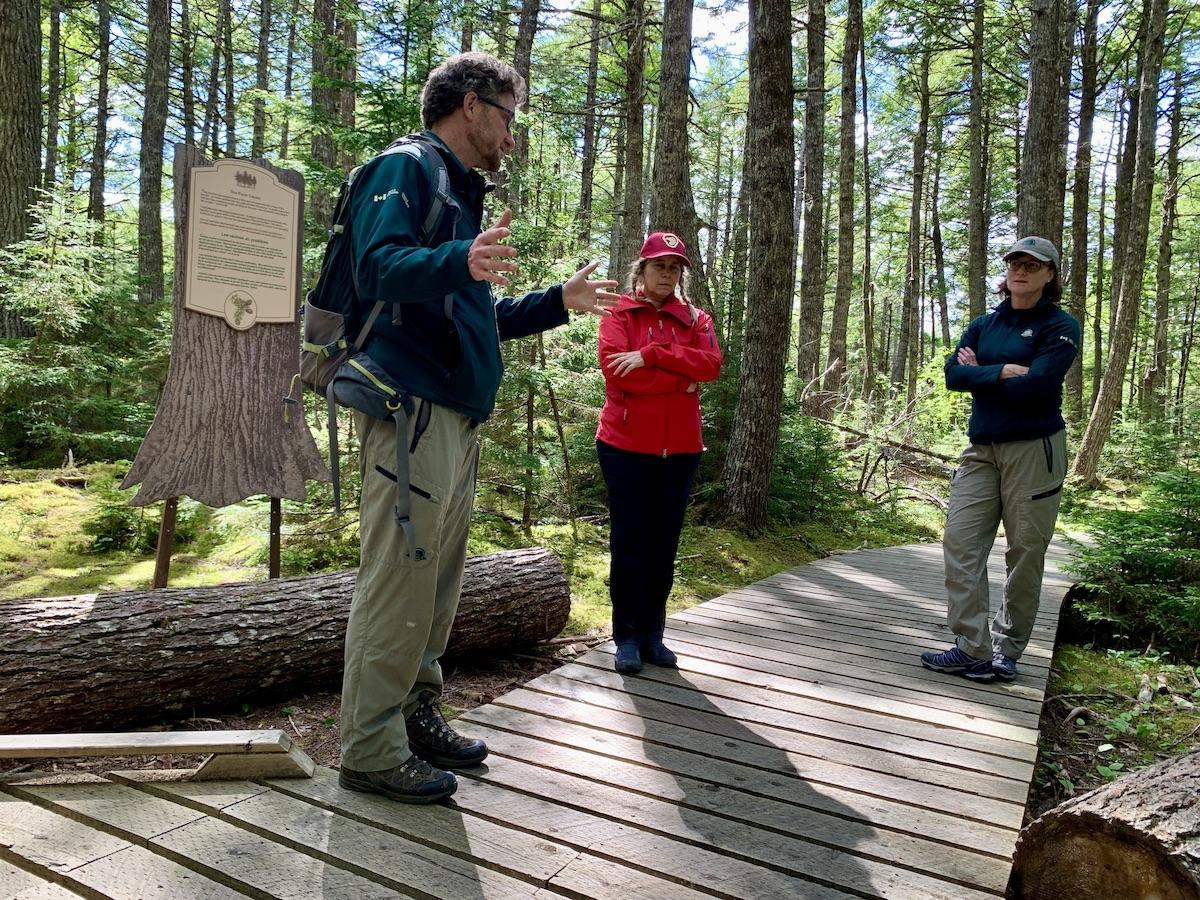
Parks Canada ecologist Matt Smith along the boardwalk that protects an old-growth hemlock stand/Parks Canada
A protective boardwalk snakes through the hemlocks, past a tree that’s touted to be 400 years old and half a dozen others that are at least 275 years old. Northern goshawks apparently love to nest in hemlocks.
In Parks Canada speak, this area is zone one and merits special preservation. Usually there wouldn’t be any visitor facilities here, but Smith says “it’s a special spot” and the boardwalk lets the park educate people while keeping them contained.
“As you enjoy the soft light and silent majesty of this forest, you must stay on the boardwalk,” a sign implores. “It has been built to protect the roots of these trees.”
The age and size of these hemlocks shows how they can out-compete and out-live other trees. But these trees require their entire root system and so even minor root damage can be devastating.
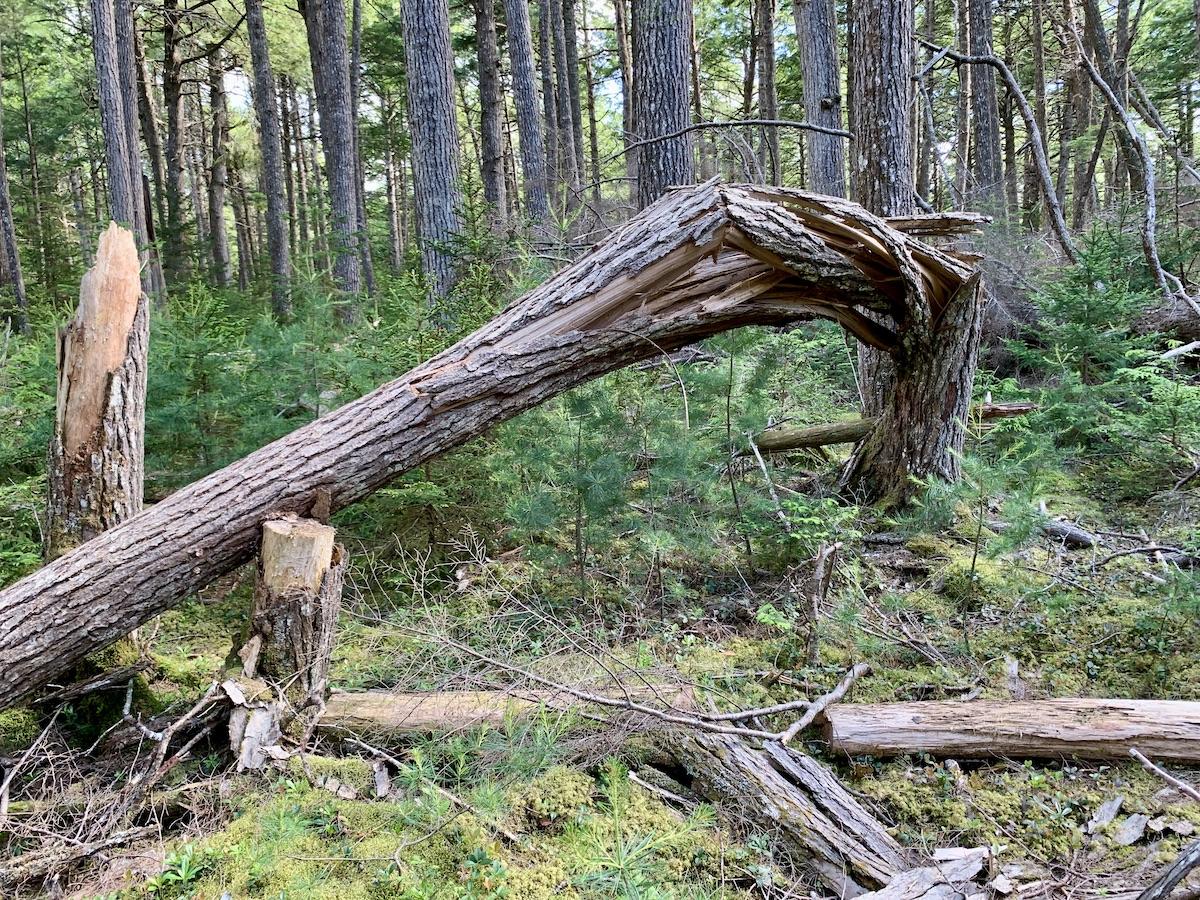
A mossy carpet and a tree felled by Hurricane Dorian/Jennifer Bain
Moss abounds. It thrives in the shade and moisture under the hemlocks and helps hemlock seedlings grow. It’s also extremely sensitive to trampling, so yet another reason to stay on the boardwalk. “The future of this forest depends on your respect for even the tiniest species,” a sign implores.
Parks Canada is three years into a five-year, $2.1-million ($1.6-million USD) plan to boost its understanding of HWA, enhance the resiliency of infested forests, slow the spread of the invasive pest within and beyond Keji, and limit the impact on these old-growth forests.
Staff started surveying priority hemlock stands in 2018 to determine the scope of the infestations. In 2020, they started recording baseline hemlock canopy health conditions.
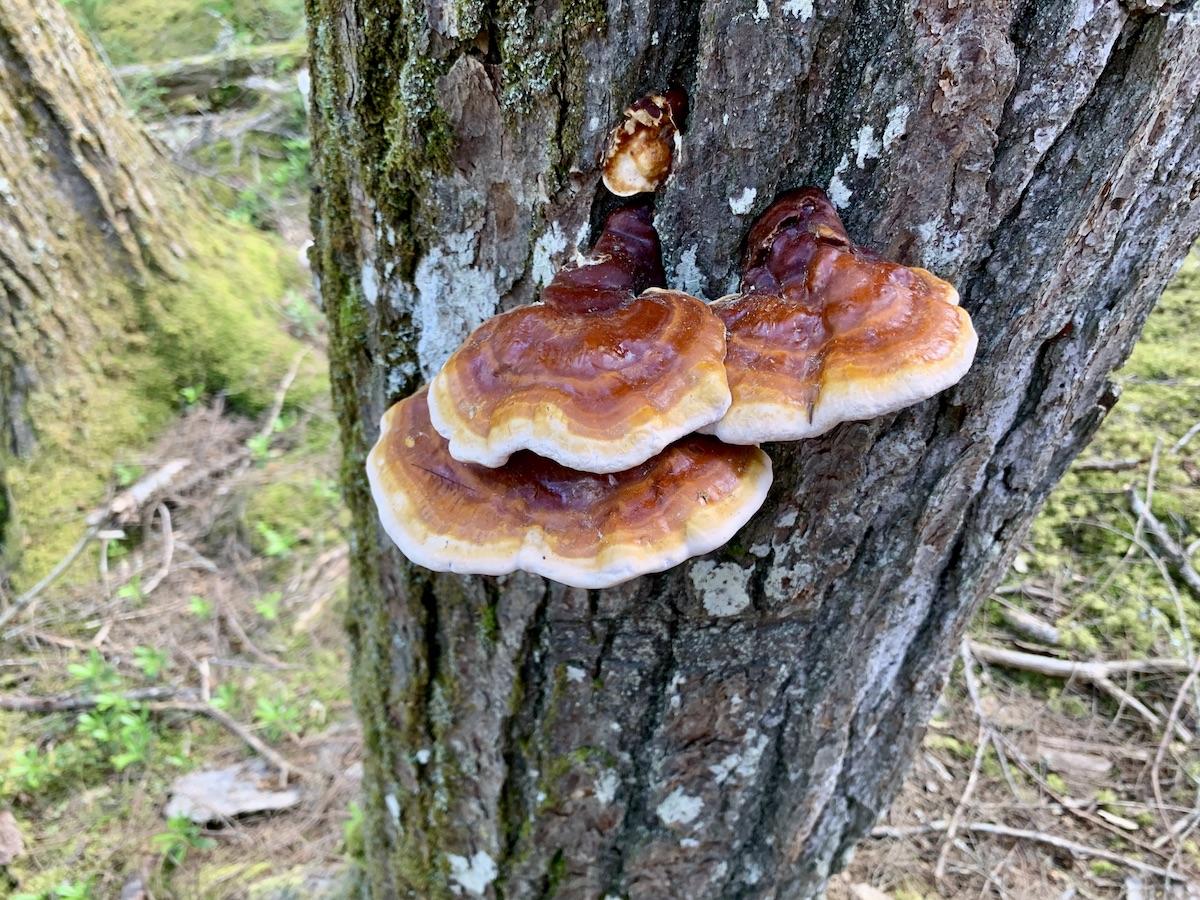
Signs of life on a tree in the hemlock forest/Jennifer Bain
Restorative silviculture is one technique being used to help the hemlock-dominant forest transition to a more resilient hardwood forest. The goal is to remove 30 per cent of the park’s hemlocks in Jeremy's Bay Campground — 3,500 trees — so more light reaches the forest floor and to help more resilient species grow while also possibly slowing the spread of HWA. About 1,000 hemlocks have been removed so far.
When Sophie Borcoman, Keji’s visitor experience manager, tours us around the campground before we settle into our oTENTiks (a tent-cabin hybrid) for a two-night stay, we see first-hand where the forest is being thinned of hemlocks and diversified.
At the Ôasis pods, a treehouse-like type of roofed accommodation, live edge stairs are made from hemlock. At one of the park's new accessible, all-gender washroom and shower facilities, the cooking shelter is quietly home to a few hemlock benches and tables.
“We took advantage of trees that we had to take down,” explains Borcoman.
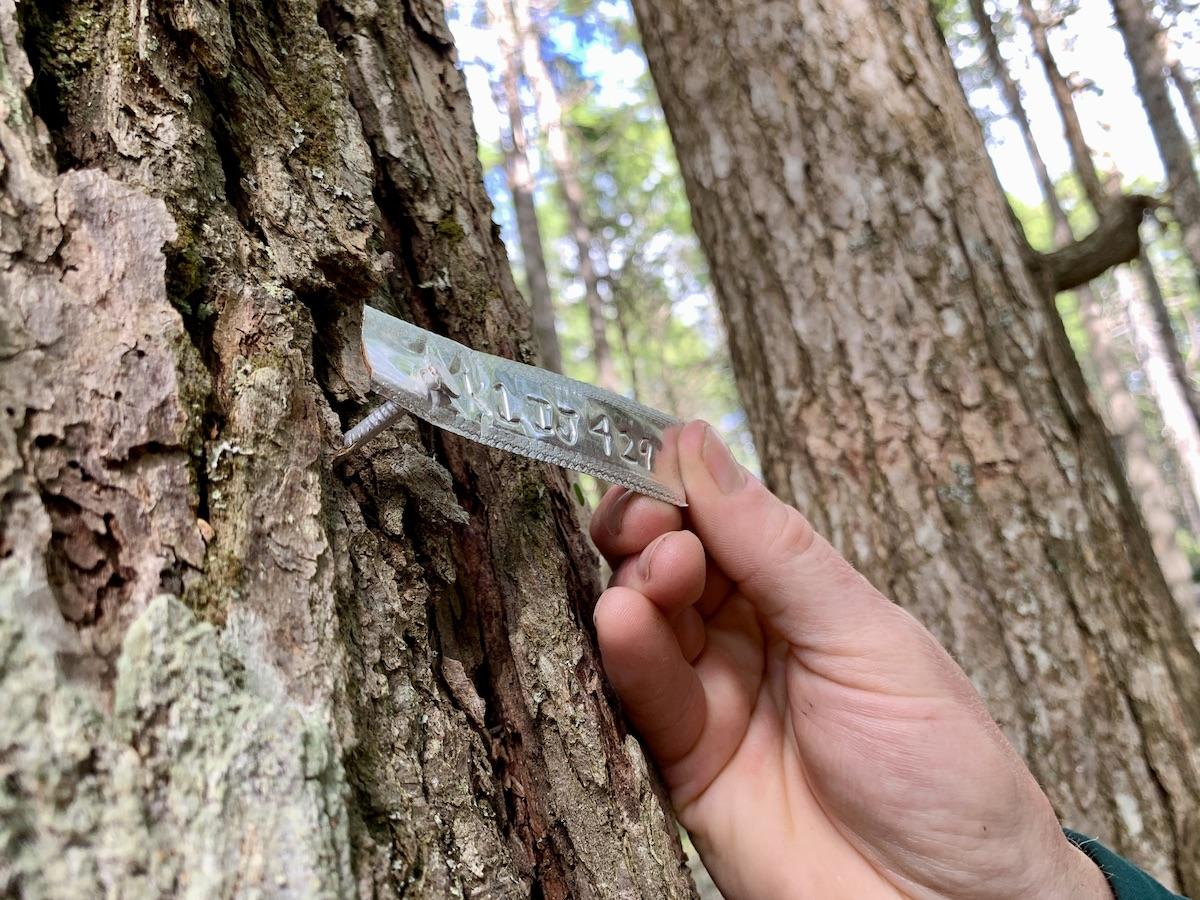
Hemlocks are tagged once they have been treated with a chemical insecticide/Jennifer Bain
In 2021, with the help of campers and other volunteers, the park planted 1,750 saplings, including 350 within exclosure fencing to avoid deer browse. The trees included hardwoods (red oak, yellow birch and sugar maple) and softwoods (red spruce and white pine).
That’s the feel-good side of the HWA battle. The trickier side involves trying chemical insecticides on prioritized hemlock stands. There is evidence that certain systemic insecticides will significantly reduce HWA populations and protect individual trees for up to seven years with minimal impacts on surrounding biodiversity. Parks Canada has directly injected (via stem injection) 432 large Eastern hemlocks with imidacloprid, a neonicotinoid insecticide, in the Hemlocks and Hardwoods trail area and 39 in Jeremy’s Bay Campground.
“We’re in a long game and the only thing you can use to protect the trees in the short term are pesticides,” says Smith. “It’s not a lifetime of protection, but it will help them survive for the next little while.
“The analogy is you’re giving the tree medicine to help it survive.”
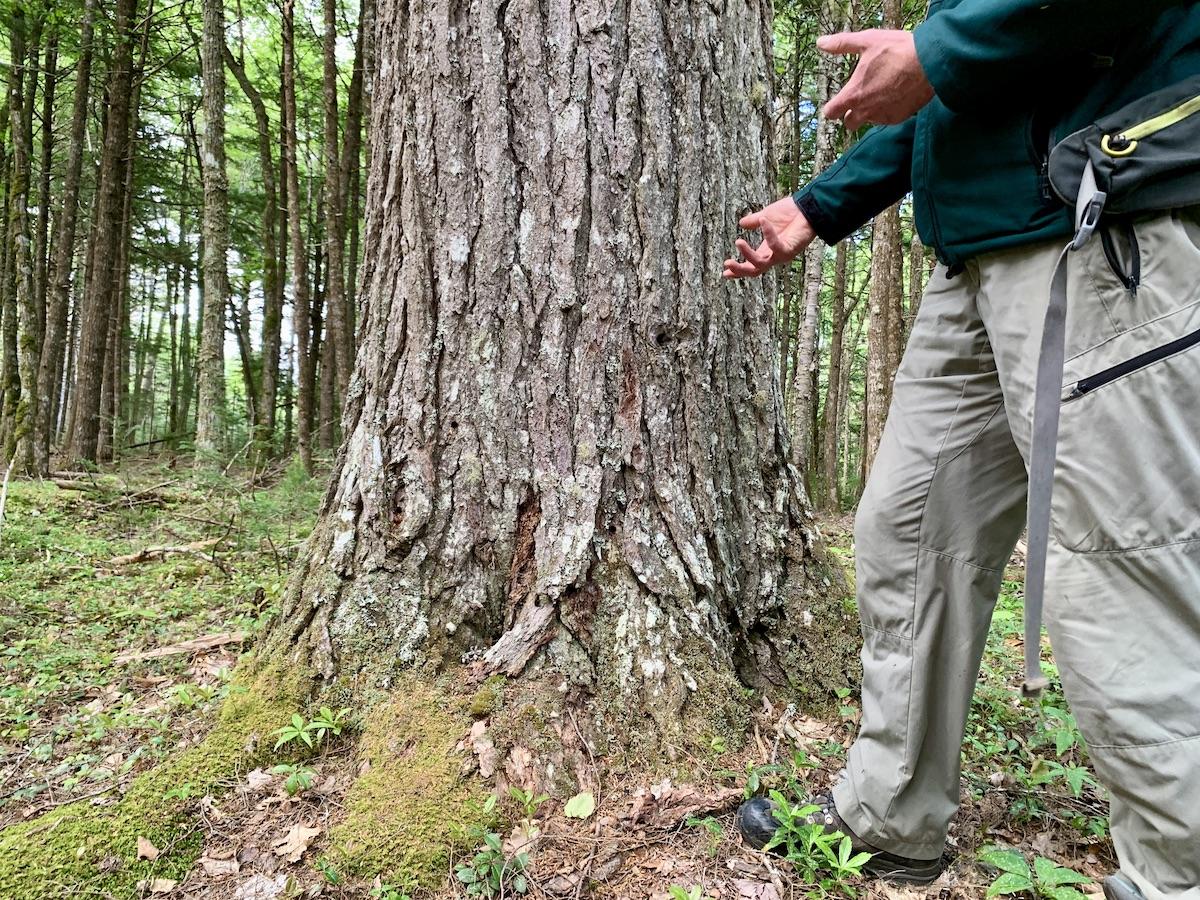
Parks Canada ecologist Matt Smith demonstrates how hemlocks are injected with insecticide/Jennifer Bain
Smith leads us to a tree right by the boardwalk with several holes in it. He explains how hemlocks are injected with the insecticide using a tool that looks like a glue gun. A numbered silver tag is then discreetly attached to the tree — usually where hikers can’t see it — and it’s quietly monitored.
We spot one forest patch with a series of ribbons and markers. It’s one of four research plots where 117 hemlocks are being treated with Xytect 2F to control HWA. Xytect 2F is an imidacloprid product similar to the pesticide injected in the trees, explains Smith, but this basal bark spray is easier to apply and much more cost effective. It's also not approved yet in Canada. Acadia University and the Canadian Forest Service is testing this product to see if there are any impacts of pollinators in treated stands. If Xytect 2F earns Canadian approval, more hemlocks could be helped with the same amount of money.
The Canadian Food Inspection Agency suspects the future of HWA control will be “a mixture of natural enemies and well-timed applications of specific pesticides, called integrated pest management.” Test releases of a tiny ladybird beetle (Pseudoscymnus tsugae) that feeds on three types of adelgids are promising. Laricobius nigrinus — another beetle in western North America that feeds on the HWA — is being investigated as a biocontrol agent. Some predatory beetles found currently only in Asia are also being tested to see if they can be safely imported and released in North America.
Parks Canada is working with Acadia University, the Canadian Forest Service and the Confederacy of Mainland Mi’kmaq on three hemlock-related research projects studying things like the non-target impacts of imidacloprid on invertebrates and pollinators, fungi in treated and untreated old-growth stands, and the impacts of imidacloprid on the mycorrhizal networks (underground fungal connections) of old-growth stands.
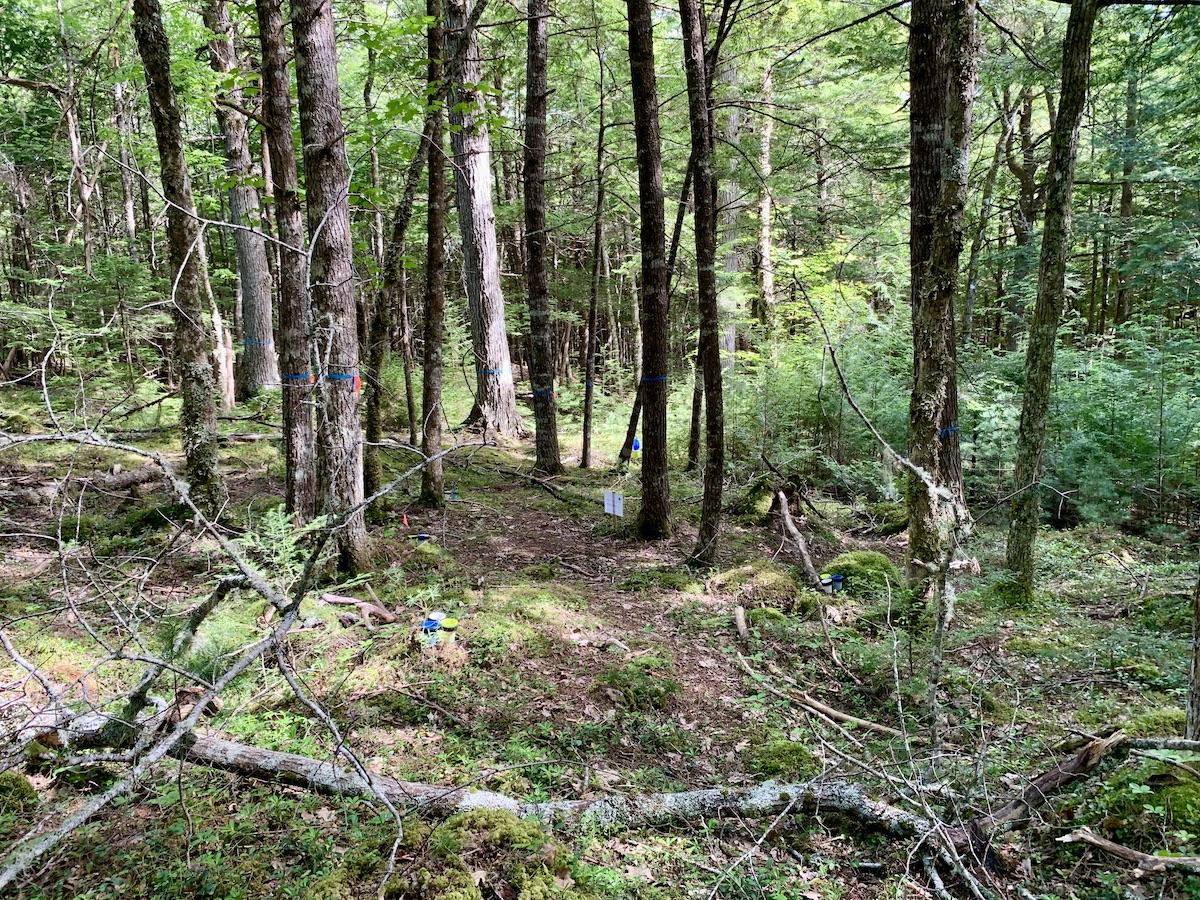
A patch of hemlock forest that's being treated with an experimental basal bark spray/Jennifer Bain
Throughout our hike, we hear talk of “Dorian.” Hurricane Dorian walloped Nova Scotia in 2019 and tore through Keji’s forests, felling old hemlocks and opening the forest canopy. Rotting “nurse logs” abound, as do delicate seedlings. Young trees mix with the mighty hemlocks and everything works together to provide critical habitat for birds, plant and fungi.
Near the end of the protective boardwalk portion, we stop at what remains of one of Keji’s much-photographed hemlocks.
The gnarly tree grew in a thin layer of moss and soil on top of a granite boulder for 150 to 200 years, and its roots snaked over the rock to the ground. But people couldn’t resist climbing on the rock, damaging the soil and the iconic tree’s extremely shallow and fragile roots. Dorian did the tree in and so now most of it lies on the forest floor and only a stump remains on the boulder.
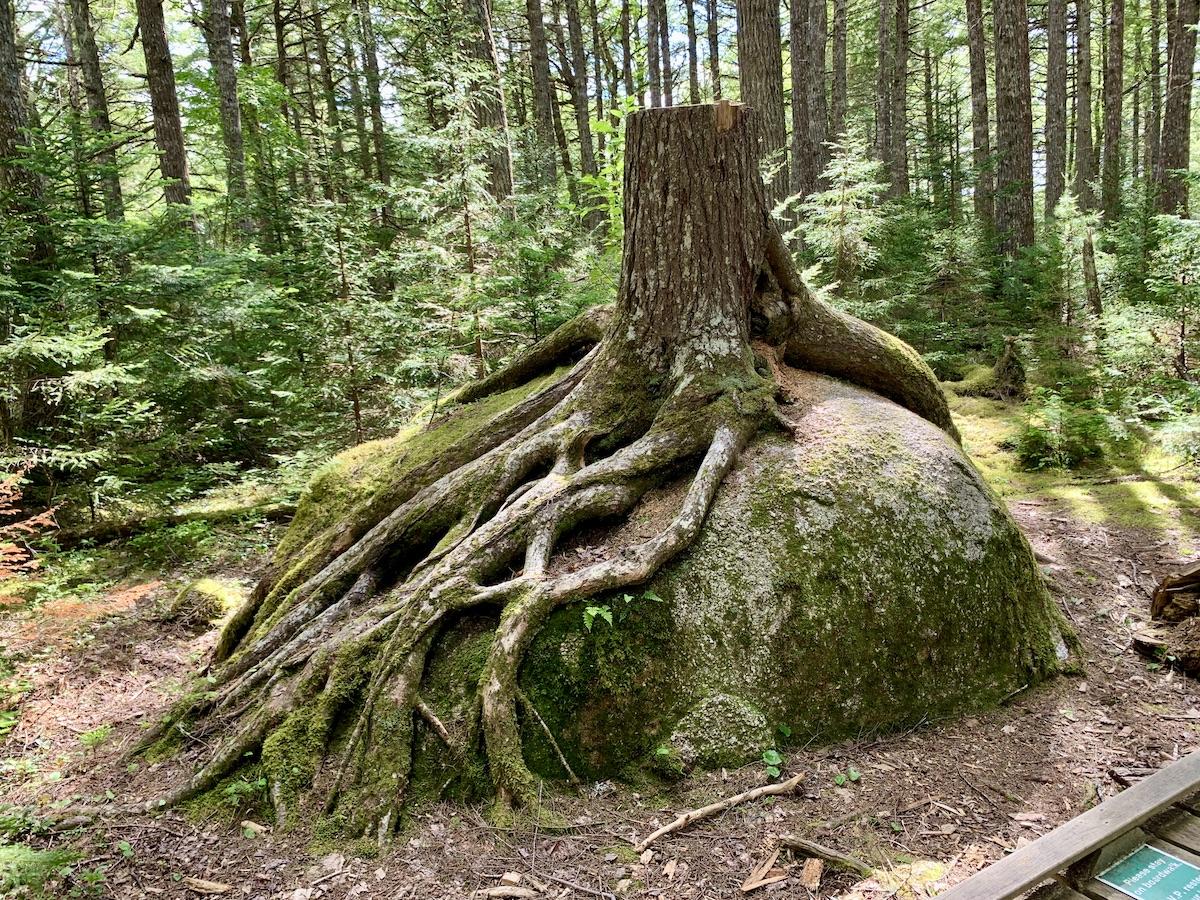
Only a stump remains where an iconic hemlock once grew on a boulder/Jennifer Bain
It won’t be one of the lucky hemlocks that gets an insecticide injection.
“It’s going to be sad for a lot of visitors,” Smith predicts. “We’re hopeful for some of the places we’re treating but it’s a big problem, there are a lot of hemlocks in the park and it’s not a simple solution. We can help protect old-growth stands but we’re not going to be able to protect every hemlock tree.”
He’s part of a team preparing to hike and canoe into a remote part of the park this fall to treat another 1,000 old-growth hemlocks.
“We’re racing to save these stands before the impacts get too great. A lot of people care very deeply about hemlock trees.”

Comments
Excellent article. So depressing. I treated my century-old backyard hemlock in western Pennsylvania this spring with a pesticide root drench available over the counter at the farm store. My neighbor did the same and his has much more new growth than mine. Taking it down will cost a fortune if it succumbs to HWA as it leans toward the house. Pennsylvania has 600 year-old hemlocks maybe older at Cook Forest and Allan Seeger parks.